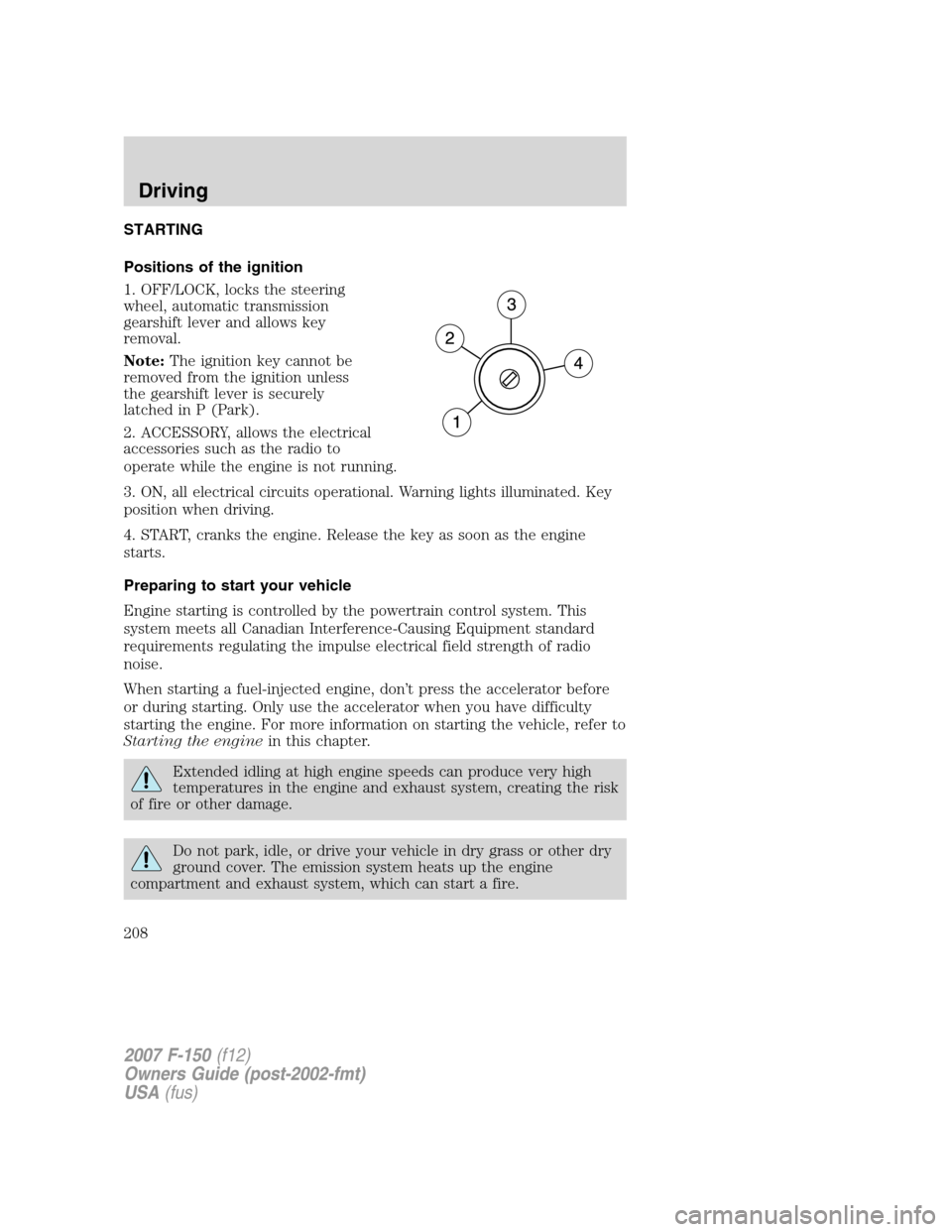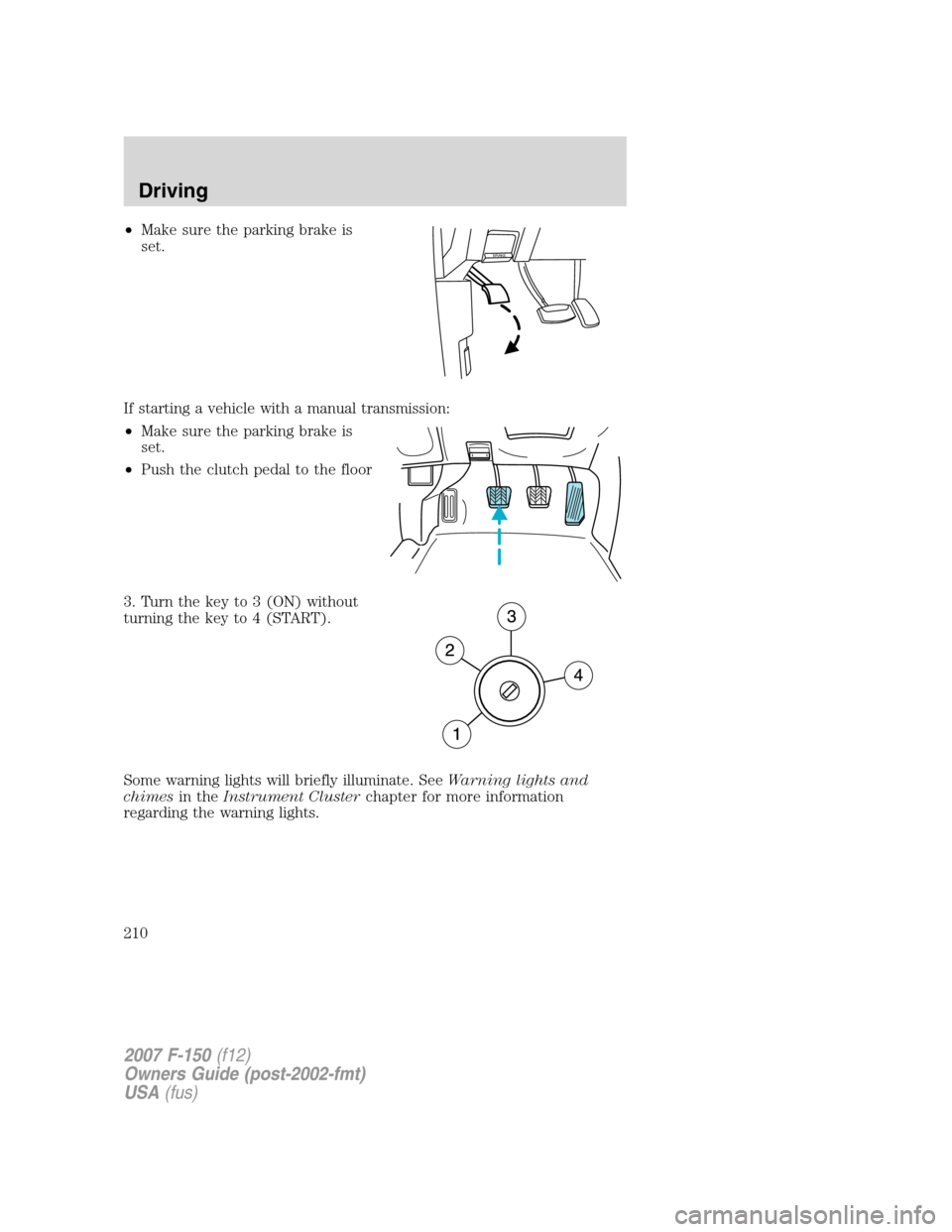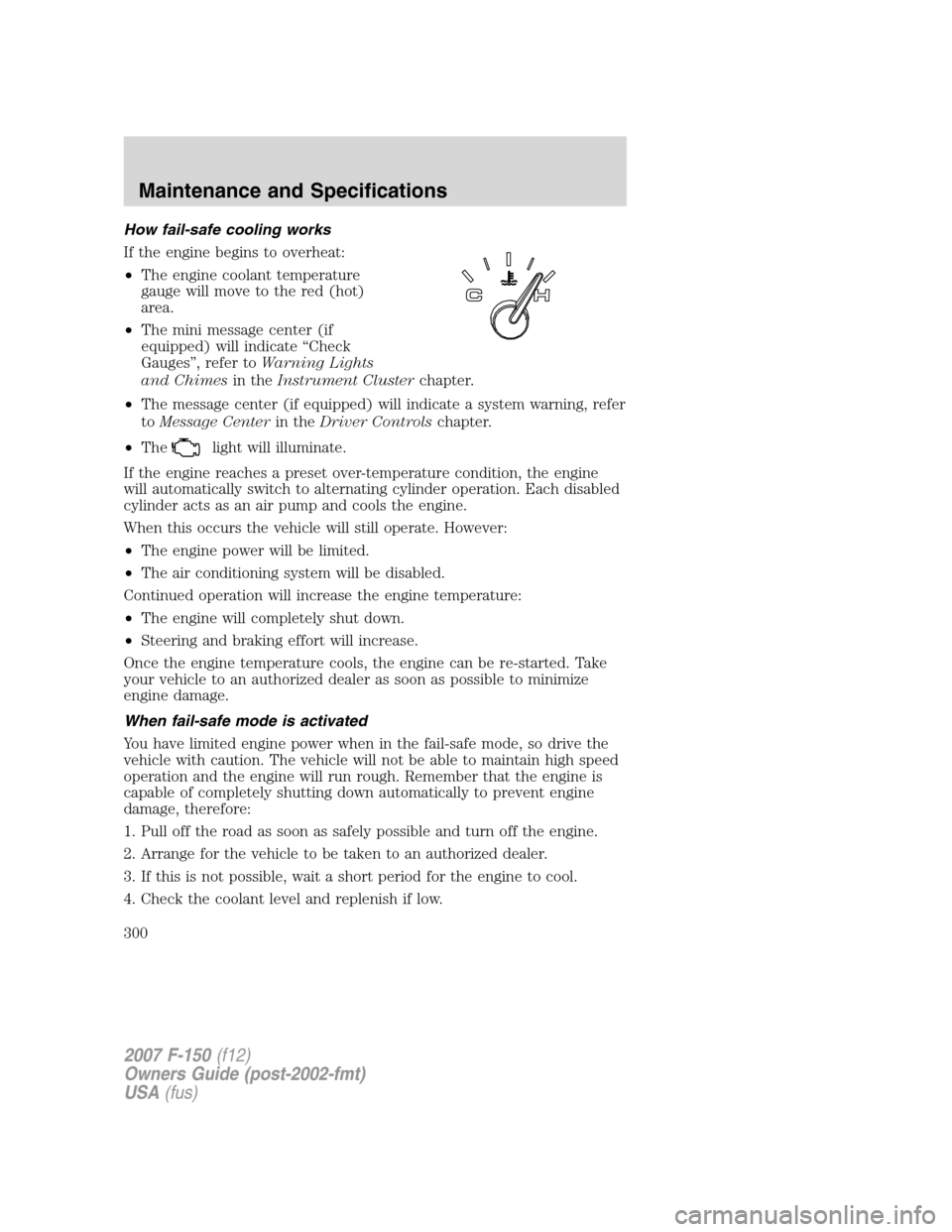2007 FORD F150 lights
[x] Cancel search: lightsPage 204 of 344

Trailer brakes
Electric brakes and manual, automatic or surge-type trailer brakes are
safe if installed properly and adjusted to the manufacturer’s
specifications. The trailer brakes must meet local and Federal
regulations.
Do not connect a trailer’s hydraulic brake system directly to your
vehicle’s brake system. Your vehicle may not have enough
braking power and your chances of having a collision greatly increase.
The braking system of the tow vehicle is rated for operation at the
GVWR not GCWR.
Trailer lamps
Trailer lamps are required on most towed vehicles. Make sure all running
lights, brake lights, turn signals and hazard lights are working. See your
authorized dealer or trailer rental agency for proper instructions and
equipment for hooking up trailer lamps.
Using a step bumper (if equipped)
The rear bumper is equipped with an integral hitch and only requires a
ball with a one inch (25.4 mm) shank diameter. The bumper has a 5,000
lb. (2,270 kg) trailer weight and 500 lb. (227 kg) tongue weight capacity.
If it is necessary to relocate the trailer hitch ball position, a
frame-mounted trailer hitch must be installed.
Driving while you tow
When towing a trailer:
•Keep your speed no faster than 70 mph (112 km/h) during the first
500 miles (800 km) of towing a trailer, and don’t make full throttle
starts.
•Turn off the speed control. The speed control may shut off
automatically when you are towing on long, steep grades.
•Consult your local motor vehicle speed regulations for towing a trailer.
•To eliminate excessive shifting, use a lower gear. This will also assist
in transmission cooling. (For additional information, refer to
Understanding the gearshift positions of the 4–speed automatic
transmissionin theDriving chapter.
•Anticipate stops and brake gradually.
2007 F-150(f12)
Owners Guide (post-2002-fmt)
USA(fus)
Tires, Wheels and Loading
204
Page 208 of 344

STARTING
Positions of the ignition
1. OFF/LOCK, locks the steering
wheel, automatic transmission
gearshift lever and allows key
removal.
Note:The ignition key cannot be
removed from the ignition unless
the gearshift lever is securely
latched in P (Park).
2. ACCESSORY, allows the electrical
accessories such as the radio to
operate while the engine is not running.
3. ON, all electrical circuits operational. Warning lights illuminated. Key
position when driving.
4. START, cranks the engine. Release the key as soon as the engine
starts.
Preparing to start your vehicle
Engine starting is controlled by the powertrain control system. This
system meets all Canadian Interference-Causing Equipment standard
requirements regulating the impulse electrical field strength of radio
noise.
When starting a fuel-injected engine, don’t press the accelerator before
or during starting. Only use the accelerator when you have difficulty
starting the engine. For more information on starting the vehicle, refer to
Starting the enginein this chapter.
Extended idling at high engine speeds can produce very high
temperatures in the engine and exhaust system, creating the risk
of fire or other damage.
Do not park, idle, or drive your vehicle in dry grass or other dry
ground cover. The emission system heats up the engine
compartment and exhaust system, which can start a fire.
2007 F-150(f12)
Owners Guide (post-2002-fmt)
USA(fus)
Driving
208
Page 210 of 344

•Make sure the parking brake is
set.
If starting a vehicle with a manual transmission:
•Make sure the parking brake is
set.
•Push the clutch pedal to the floor
3. Turn the key to 3 (ON) without
turning the key to 4 (START).
Some warning lights will briefly illuminate. SeeWarning lights and
chimesin theInstrument Clusterchapter for more information
regarding the warning lights.
BRAKE
2007 F-150(f12)
Owners Guide (post-2002-fmt)
USA(fus)
Driving
210
Page 227 of 344

The RSS automatically turns on
when the gearshift lever is placed in
R (Reverse) and the ignition is ON.
An RSS control allows the driver to
turn the RSS on and off. To turn the
RSS off, the ignition must be ON,
and the gear selector in R
(Reverse). An indicator light on the
control will illuminate when the system is turned off. If the indicator
light illuminates when the RSS is not turned off, it may indicate a failure
in the RSS. The RSS will remain off until either the RSS control is
pushed again or the ignition switch is recycled.
Keep the RSS sensors (located on the rear bumper/fascia) free
from snow, ice and large accumulations of dirt (do not clean the
sensors with sharp objects). If the sensors are covered, it will
affect the accuracy of the RSS.
If your vehicle sustains damage to the rear bumper/fascia, leaving
it misaligned or bent, the sensing zone may be altered causing
inaccurate measurement of obstacles or false alarms.
FOUR-WHEEL DRIVE (4WD) OPERATION (IF EQUIPPED)
For important information regarding safe operation of this type
of vehicle, seePreparing to drive your vehiclein this chapter.
Four–wheel drive (4WD) supplies power to all four wheels. 4WD should
not be operated on dry pavement; driveline damage may occur.
If equipped with the Electronic Shift 4WD System, and 4WD Low
is selected while the vehicle is moving above 3 mph (5 km/h), the
4WD system will not engage past 4WD High. This is normal and
should be no reason for concern.Refer toShifting to/from 4L (4WD
Low)for proper operation.
System indicator lights
•4X4 HI- Momentarily illuminates
when the engine is started.
Illuminates when 4H is selected.
4x4 HI
2007 F-150(f12)
Owners Guide (post-2002-fmt)
USA(fus)
Driving
227
Page 300 of 344

How fail-safe cooling works
If the engine begins to overheat:
•The engine coolant temperature
gauge will move to the red (hot)
area.
•The mini message center (if
equipped) will indicate “Check
Gauges”, refer toWarning Lights
and Chimesin theInstrument Clusterchapter.
•The message center (if equipped) will indicate a system warning, refer
toMessage Centerin theDriver Controlschapter.
•The
light will illuminate.
If the engine reaches a preset over-temperature condition, the engine
will automatically switch to alternating cylinder operation. Each disabled
cylinder acts as an air pump and cools the engine.
When this occurs the vehicle will still operate. However:
•The engine power will be limited.
•The air conditioning system will be disabled.
Continued operation will increase the engine temperature:
•The engine will completely shut down.
•Steering and braking effort will increase.
Once the engine temperature cools, the engine can be re-started. Take
your vehicle to an authorized dealer as soon as possible to minimize
engine damage.
When fail-safe mode is activated
You have limited engine power when in the fail-safe mode, so drive the
vehicle with caution. The vehicle will not be able to maintain high speed
operation and the engine will run rough. Remember that the engine is
capable of completely shutting down automatically to prevent engine
damage, therefore:
1. Pull off the road as soon as safely possible and turn off the engine.
2. Arrange for the vehicle to be taken to an authorized dealer.
3. If this is not possible, wait a short period for the engine to cool.
4. Check the coolant level and replenish if low.
2007 F-150(f12)
Owners Guide (post-2002-fmt)
USA(fus)
Maintenance and Specifications
300
Page 308 of 344

If you have run out of fuel:
•You may need to cycle the ignition from OFF to ON several times after
refueling to allow the fuel system to pump the fuel from the tank to
the engine. On restarting, cranking time will take a few seconds longer
than normal.
•Normally, adding one gallon of fuel is enough to restart the engine. If
the vehicle is out of fuel and on a steep grade, more than one gallon
may be required.
•The
indicator may come on. For more information on the “check
engine” or the “service engine soon” indicator, refer toWarning lights
and chimesin theInstrument Clusterchapter.
ESSENTIALS OF GOOD FUEL ECONOMY
Measuring techniques
Your best source of information about actual fuel economy is you, the
driver. You must gather information as accurately and consistently as
possible. Fuel expense, frequency of fill-ups or fuel gauge readings are
NOT accurate as a measure of fuel economy. We do not recommend
taking fuel economy measurements during the first 1,000 miles (1,600
km) of driving (engine break-in period). You will get a more accurate
measurement after 2,000 miles-3,000 miles (3,000 km–5,000 km).
Filling the tank
The advertised fuel capacity of the fuel tank on your vehicle is equal to
the rated refill capacity of the fuel tank as listed in theMaintenance
product specifications and capacitiessection of this chapter.
The advertised capacity is the amount of the indicated capacity and the
empty reserve combined. Indicated capacity is the difference in the
amount of fuel in a full tank and a tank when the fuel gauge indicates
empty. Empty reserve is the small amount of fuel remaining in the fuel
tank after the fuel gauge indicates empty.
The amount of usable fuel in the empty reserve varies and should
not be relied upon to increase driving range. When refueling your
vehicle after the fuel gauge indicates empty, you might not be
able to refuel the full amount of the advertised capacity of the
fuel tank due to the empty reserve still present in the tank.
For consistent results when filling the fuel tank:
•Turn the engine/ignition switch to the off position prior to refueling,
an error in the reading may result if the engine is left running.
2007 F-150(f12)
Owners Guide (post-2002-fmt)
USA(fus)
Maintenance and Specifications
308
Page 336 of 344

checking and adding ..............289
dipstick ....................................289
filter, specifications ........292, 322
recommendations ...................292
refill capacities ........................324
specifications ..........................324
Exhaust fumes ..........................212
F
Fail safe cooling ........................299
Flexible Fuel Vehicle (FFV) ....301
Floor mats ...................................97
Fluid capacities .........................324
Foglamps .....................................59
Four-Wheel Drive vehicles .......227
driving off road .......................231
electronic shift ................229–230
indicator light .........................227
lever operated shift ................228
preparing to drive your
vehicle .....................................217
Fuel ............................................301
calculating fuel
economy ............................92, 308
cap ...........................................304
capacity ...................................324
choosing the right fuel ...........305
comparisons with EPA fuel
economy estimates .................311
detergent in fuel .....................306
filling your vehicle with
fuel ...........................301, 304, 308
filter, specifications ........301, 322
fuel pump shut-off switch .....243
improving fuel economy ........308
octane rating ...................306, 328
quality ......................................307
running out of fuel .................307safety information relating to
automotive fuels .....................301
Fuel - flex fuel vehicle
(FFV) .........................301, 305–306
Fuel pump shut-off switch .......243
Fuses ..................................244–245
G
Gas cap (see Fuel cap) ............304
Gas mileage
(see Fuel economy) .................308
Gauges .........................................19
H
Hazard flashers .........................243
Head restraints .................115, 119
Headlamps ...................................58
aiming ........................................60
autolamp system .......................58
bulb specifications ....................63
daytime running lights .............59
flash to pass ..............................59
high beam .................................59
replacing bulbs .........................64
turning on and off ....................58
Heating
heater only system ...................48
heating and air conditioning
system ...........................49, 51, 54
Homelink wireless control
system ..........................................83
Hood ..........................................284
How to get going ........................22
I
Ignition ...............................208, 328
2007 F-150(f12)
Owners Guide (post-2002-fmt)
USA(fus)
Index
336
Page 337 of 344

Illuminated visor mirror .............69
Infant seats
(see Safety seats) .....................153
Inspection/maintenance (I/M)
testing ........................................313
Instrument panel
cleaning ...................................277
cluster ........................................12
lighting up panel and
interior .......................................60
J
Jack ............................................252
positioning ...............................252
storage .....................................252
Jump-starting your vehicle ......259
K
Keyless entry system ...............110
autolock ...................................101
keypad .....................................110
locking and unlocking doors ..111
programming entry code .......111
Keys ...................................101, 113
positions of the ignition .........208
L
Lamps
autolamp system .......................58
bulb replacement
specifications chart ..................63
daytime running light ...............59
fog lamps ...................................59
headlamps .................................58
headlamps, flash to pass ..........59
instrument panel, dimming .....60
interior lamps .....................62–63
replacing bulbs ...................64, 67Lane change indicator
(see Turn signal) ........................61
Lights, warning and indicator ....12
anti-lock brakes (ABS) ..........213
Load limits .................................188
Loading instructions .................194
Locks
autolock ...................................101
childproof ................................103
doors ........................................101
Lubricant specifications ...........324
Lug nuts ....................................259
Lumbar support, seats .............117
M
Manual transmission .................223
reverse .....................................225
Message center ...........................89
english/metric button ...............93
system check button ................93
warning messages .....................94
Mirrors .........................................77
automatic dimming rearview
mirror ........................................76
fold away ...................................77
heated ........................................78
programmable memory ..........106
side view mirrors (power) .......77
signal .........................................78
Moon roof ....................................82
Motorcraft parts ........281, 301, 322
N
Navigation system .......................47
O
Octane rating ............................306
2007 F-150(f12)
Owners Guide (post-2002-fmt)
USA(fus)
Index
337